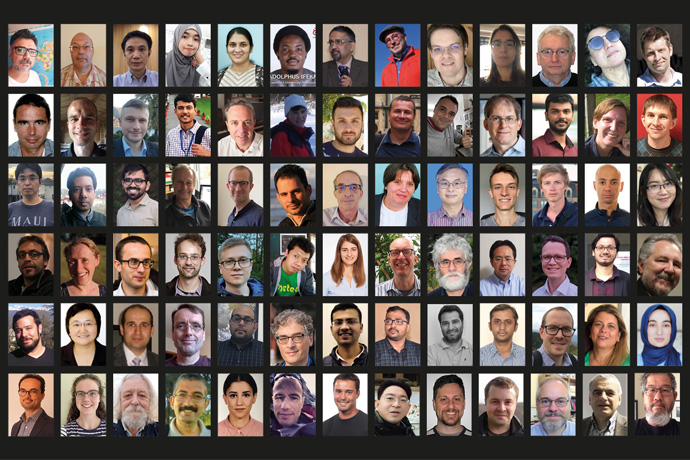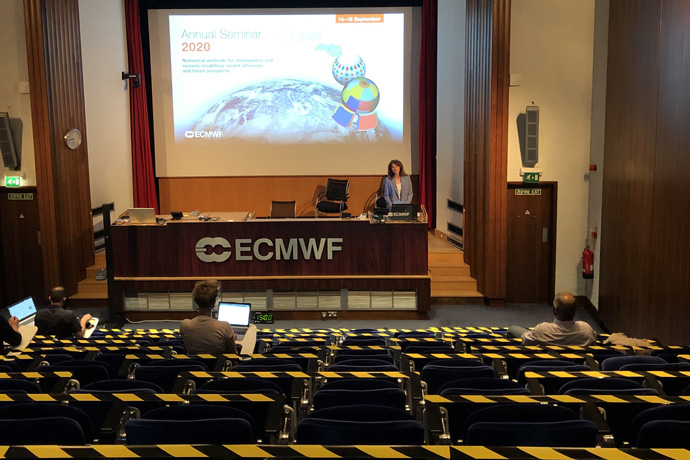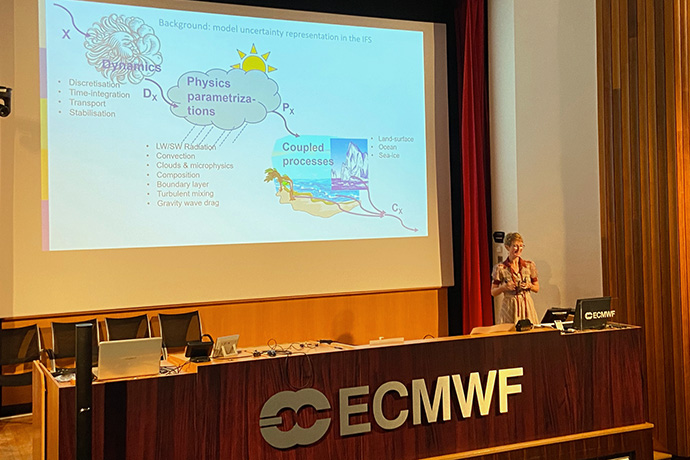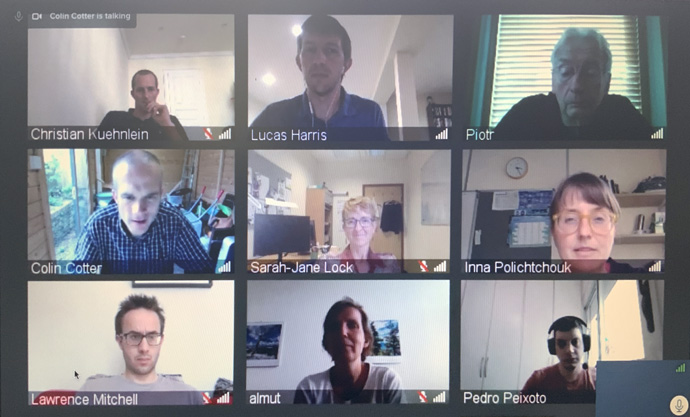

More than 300 researchers from across the world joined the ECMWF Annual Seminar 2020 on 'Recent developments in numerical methods for atmospheric and oceanic modelling', which was held online from 14 to 18 September.
The 27 speakers described the state of the art in computational methods for solving the equations that govern atmospheric, wave, ocean and sea-ice dynamics. Such numerical solvers are fundamental components of weather and climate prediction models.
The advent of a new generation of exascale supercomputing architectures has sparked renewed interest in the development of numerical methods that can work efficiently on such machines and that can solve the prognostic equations of global weather and climate at spatial scales that until recently were possible only with limited-area models. This was very much reflected in this year’s Seminar talks, in which an impressive range of new developments was summarised.

ECMWF Director-General Florence Rabier opened the 2020 Annual Seminar. Although the on-site audience was limited to the eight socially distanced speakers from ECMWF, over 300 participants registered to take part in the live-streamed lectures, poster sessions and discussion groups.
Progress in atmospheric modelling
A noticeable trend in global atmospheric models is the gradual move from spectral or finite-difference spatial discretizations to local compact stencil discretizations such as finite-volume, finite-element or discontinuous-Galerkin. Similarly, there is a shift from semi-implicit semi-Lagrangian integration methods to Eulerian methods with various time-stepping techniques (e.g. split-explicit, implicit-explicit, semi-implicit). The main benefits of these new developments: high parallel scalability and conservation of transported quantities.
Speakers demonstrated a new generation of conserving global non-hydrostatic dynamical cores which are either under development or already in use for operations or research. Impressive results were shown, demonstrating the progress with these new dynamical cores. These included a first demonstration of a successful hurricane forecast with the ECMWF finite volume dynamical core that is currently under development. Furthermore, abstractions of equation sets based on Hamiltonian approaches were shown to facilitate the development of flexible and general models for simulating not only the Earth’s atmosphere but also those of other planets.
As there is no such thing as a perfect numerical method, there is no single avenue being explored. New techniques emerge, but current techniques also improve and become more competitive. For example, thanks to algorithmic improvements in spectral transforms and the introduction of faster, but equally skilful in terms of forecast error, reduced-precision arithmetic, it is possible to run near 1 km resolution experimental forecasts with the ECMWF spectral model for a full season. The quality of results from these simulations challenges the common belief that non-hydrostatic formulations would be required at this resolution.
Furthermore, work to apply spectral transforms on other than Gaussian grids to form the basis of nestable multigrid semi-implicit solvers brings new opportunities for global high-resolution modelling with spectral techniques. Improvements in semi-Lagrangian advection methods help to address temperature biases and further improve their accuracy, while high-order discontinuous-Galerkin semi-Lagrangian schemes offer the opportunity for sophisticated p-adaptive, accurate solutions with improved conservation properties in the future.
Speakers also summarised recent progress in limited-area modelling. Improvements in semi-implicit time integration methods allow the use of the highly efficient spectral constant coefficient Helmholtz solver approach to be applied to domains with very steep orography and at very fine grid resolutions. Alternative gridpoint-based Helmholtz solver approaches for very steep orography are also being investigated, yielding promising results in non-hydrostatic model tests. Work in physics-dynamics coupling and ocean coupling is improving predictions for extreme weather systems such as tropical cyclones.
Seamless, unified time-stepping approaches on different variants of governing equation sets were also presented. New results and research using schemes for solving the transport equations were summarised, providing interesting comparisons of existing methods and proposing alternatives to dominant Eulerian explicit or semi-Lagrangian approaches. A new semi-Lagrangian-based approach, for representing uncertainty in ensemble forecasts in the solution of transport equations was presented, showing promising results.

Sarah-Jane Lock (ECMWF) presented work on representing model uncertainty associated with part of the dynamical core in ECMWF’s Integrated Forecasting System (IFS).
Exponential integrators and parallel-in-time methods, being capable of parallelisation in both space and time, were also covered in the Seminar, showing an alternative way that massive parallelism can be exploited, especially at longer time integrations.
Progress in ocean modelling
Coupled atmosphere–ocean models have traditionally been used in climate modelling but are now commonly used by medium-range weather prediction systems, which are becoming sophisticated Earth system models. As ocean models grow in sophistication and complexity and become able to resolve smaller eddies, they are facing similar technical challenges as atmospheric models.
Speakers described equation sets and presented ocean and climate simulation results from models based on finite-element or finite-volume approaches. Numerical methods on unstructured meshes are now equally efficient as structured meshes and additionally scale better on modern architectures. These new capabilities make it possible to explore new opportunities for advancing Earth system models and climate predictions. The important role that spatial resolution plays in resolving the complex ocean circulation patterns was highlighted, as well as the importance of vertical discretizations in reducing artificial mixing, concluding that a coordinate system close to isopycnal is desirable.
Accurate wave modelling is valuable for providing early warnings during extreme weather events. Different numerical approaches used in wave modelling were discussed (explicit, time-split, implicit), with speakers explaining their pros and cons and emphasizing the role of limiters in producing an accurate and physically realistic solution. Recent improvements were summarised as well as possibilities for future developments.
Speakers also highlighted the numerical challenges that the strongly non-linear and very stiff nature of sea-ice models poses. Such difficult to solve equation sets often require use of implicit approaches based on Newton methods to ensure convergence. It is anticipated that as the resolution of sea-ice models increases, it will become even more difficult to develop stable and robust solvers. This underlined the importance of conducting further research for improving the numerical methods for modelling sea-ice dynamics.
Poster and breakout sessions
For the first time in the Seminar’s 45-year history, poster sessions took place online and breakout sessions were introduced. The poster session featured nine posters covering a range of topics, such as comparing physics-dynamics coupling methods, consistent thermodynamics across model components, implementation and testing of lateral boundary conditions for dynamical cores, a new semi-Lagrangian exponential integrator dynamical core, quadrature free discontinuous-Galerkin methods, ocean modelling, and collaborative projects to adapt operational codes to heterogeneous architectures and to improve the scalability of weather and climate models.

Online breakout rooms enabled participants to explore daily lecture topics in greater depth and interact directly with the speakers, other ECMWF staff and each other, replicating somewhat the warm and informal atmosphere normally encountered in coffee and Seminar breaks.
Further information
Recordings of the talks and presentations are available on the Annual Seminar 2020 web page.
